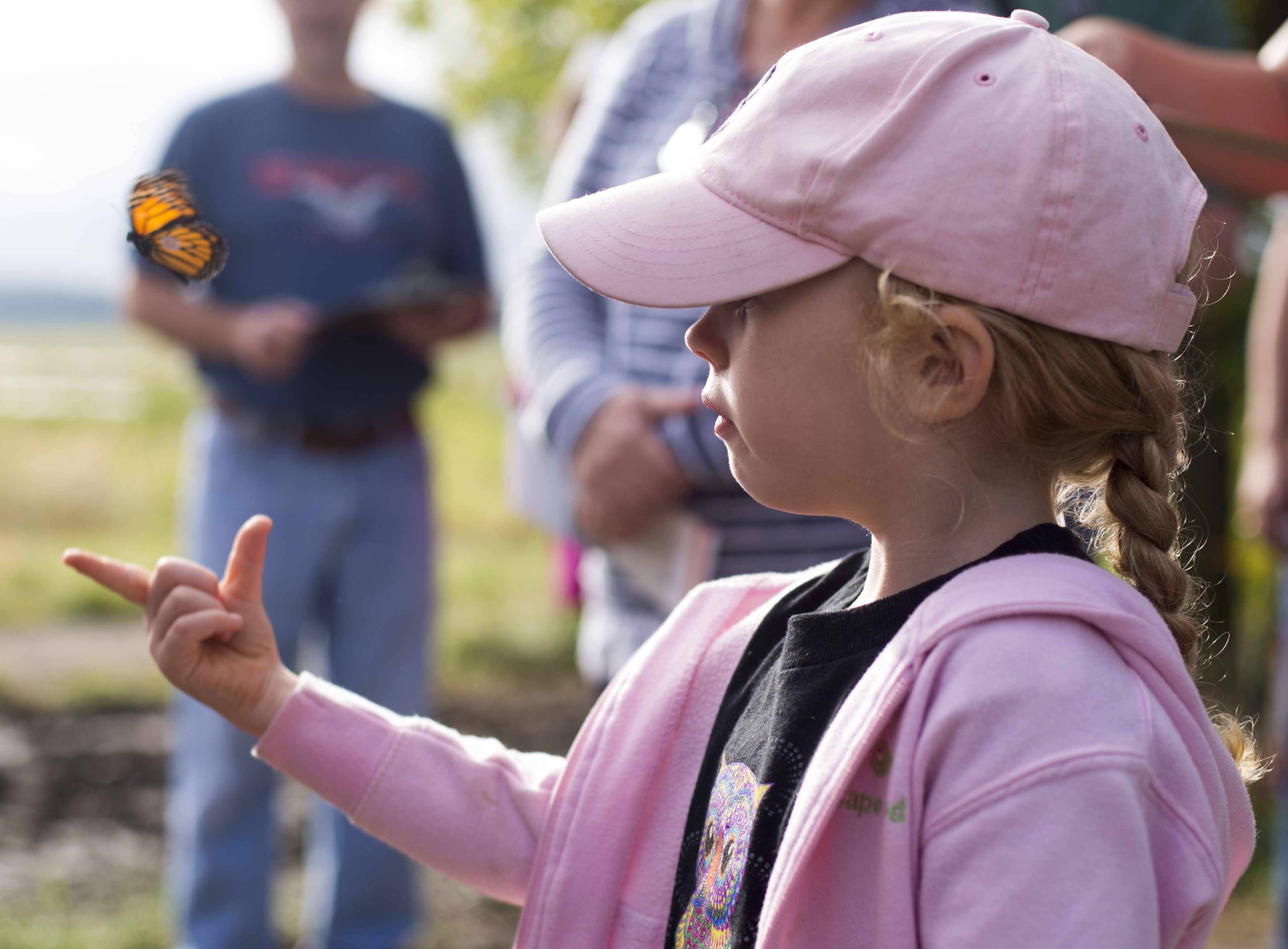Monarch Watch tagging day sets record for participants

photo by: John Young
A tagged monarch butterfly rests on a flower at the Baker Wetlands, Saturday, Sept. 17, 2016.
Ellie Ariagno made her annual return to Lawrence to help with a scientific study of another yearly return.
The 13-year-old Leawood girl was one of the participants who help band butterflies Saturday morning at the annual Monarch Watch project at the Baker Wetlands south of Lawrence.
“I’ve been coming forever,” said, before clarifying it was her fifth year attending the event. “This year I got to bring all my friends. I caught two (monarchs), but one was already tagged. The other one was a female. I’ve caught more in other years.”
Chip Taylor, director of the University of Kansas-based Monarch Watch conservation group, said the 617 participants surpassed the previous high of 551 at the previous tagging site near Clinton Lake.

photo by: John Young
Chip Taylor, of Monarch Watch, demonstrates the proper way to hold and tag a butterfly during a Monarch Watch tagging event in September 2016 at the Baker Wetlands Discovery Center.
Taylor predicts when all of this year’s national tagging efforts are totaled and entered into a database, it will be found that the overall numbers of monarchs are down. That wasn’t the case at the wetlands, which are now dotted with yellow from scattered groups of monarch-attracting wild sunflowers. Taylor suspects when Saturday’s count is tallied, 200 to 300 monarchs will have been tagged.
“There are a lot of monarchs out there,” Taylor said. “They are pretty spread out over the wetlands.”
Some of the enthusiasts saw butterflies that weren’t close enough to catch. Those willing to walk to the wetlands’ southern boundary near the Wakarusa River found abundant monarchs, Taylor said.
The fields of Douglas County and northeast Kansas have been kind to monarchs this year, Taylor said.
“There are more than the usual number of monarchs produced here this year,” he said. “I had a friend call me and say he counted 300 monarch caterpillars on plants in a field. You just don’t see 300 caterpillars.”

photo by: John Young
Five-year-old Lawrence resident Caroline Gregg-Hayes releases a tagged monarch butterfly during a Monarch Watch tagging event Saturday morning at the Baker Wetlands Discovery Center.

photo by: John Young
Ten-year-old Ava McNiel, of Overland Park, stalks a monarch butterfly through the flowers during a Monarch Watch tagging event Saturday morning at the Baker Wetlands Discovery Center.
Jeni Nadvornik, a 14-year-old homeschool student from rural Ottawa, said she and the other participants were taught how to tag the butterflies “very carefully” on the strong “mitten area” in the center part of the wing. With the help of her parents, she was able to tag the two monarchs she captured in her net.
Taylor explained the small circular tags have a special adhesive that bonds to the wing for life. Each has a six-character number/letter combination that will be added to a national database. In the last 24 years, 1.2 million tag numbers have been entered into the database and 15,000 to 16,000 “recoveries” have been recorded, Taylor said.
“That’s an absolute goldmine,” he said. “It tells us a lot about these migrations.”
The compelling story of the insects’ long annual migration from Mexico to as far north as Canada and back is one of the things about monarchs that captures the public imagination, Taylor said. It’s a trip that proves the butterfly’s fragile appearance is deceiving.
“They’re tough,” Taylor said. “They are extremely rubbery.”
Other traits boosting the insects’ popularity are their unique appearance in the caterpillar, chrysalis and adult stages and the distinctiveness of the milkweed plant that provides nutritious meals for caterpillars, Taylor said.
“There’s something charismatic about this insect,” he said. “They also are extremely accessible. They are slow enough to catch.”

photo by: John Young
Rafael Rios and Chela Ortega check to see if they nabbed a monarch butterfly in their net during a Monarch Watch tagging event Saturday morning at the Baker Wetlands Discovery Center.
But human-made challenges often threaten the tough monarchs more than the predators or weather conditions encountered on their long migrations. One factor affecting the monarchs’ numbers, Taylor said, is the agricultural-related elimination of milkweed, particularly after President George W. Bush’s administration encouraged farming of many marginal acres.
The lower monarch population is an indication of stress on other pollinators, Taylor said. The complex interactions that take place in an ecosystem mean the lack of pollinators will have adverse consequences on many other species, he said.
The last of this year’s monarchs are expected to leave the area near the end of the first week of October.
“The probability of monarchs making it to Mexico if they leave after that date goes down dramatically,” Taylor said.







